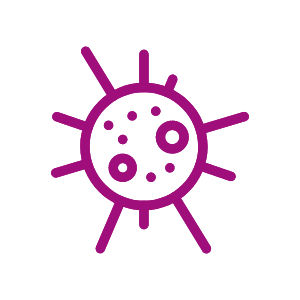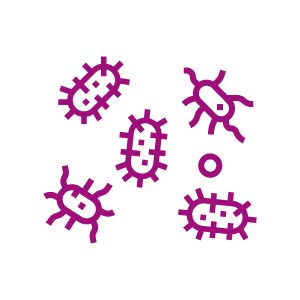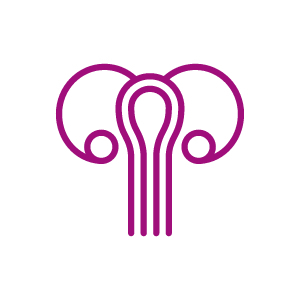Definitions
Complicated UTI
All UTIs which are not defined as uncomplicated. Meaning, in a narrower sense, UTIs in a patient with an increased chance of a complicated course: i.e. all men, pregnant women, patients with relevant anatomical or functional abnormalities of the urinary tract, indwelling urinary catheters, renal diseases, and/or with other concomitant immunocompromising diseases for example poorly controlled diabetes.
Uncomplicated UTI
Acute, sporadic or recurrent lower (uncomplicated cystitis) and/or upper (uncomplicated pyelonephritis) UTI, limited to non-pregnant women with no known relevant anatomical and functional abnormalities within the urinary tract or comorbidities.
Additional Definitions
Antibiotic resistance

The adaptation of bacteria in response to antibiotics, rendering the treatment ineffective. Antibiotic resistance is accelerated by the misuse and overuse of antibiotics, as well as poor infection prevention and control.
Antimicrobial stewardship

The aim to optimise clinical outcomes and ensure costeffective therapy, whilst minimising unintended consequences of antimicrobial use, such as healthcare associated infections (including Clostridium difficile), toxicity, selection of virulent organisms and emergence of resistant bacterial strains.
Asymptomatic bacteriuria (ABU)

ABU in an individual without urinary tract symptoms is defined by a mid-stream sample of urine showing bacterial growth a potency of 105
colony-forming units per millilitre (CFU/ml) in two consecutive samples in women and in one single sample in men.
Gut microbiota

The gut microbiome is the totality of microorganisms: bacteria, viruses, protozoa, and fungi, and their collective genetic material present in the gastrointestinal tract.
Natural reservoirs/ disease reservoirs

One or more epidemiologically connected populations or environments in which the pathogen can be permanently maintained and from which infection is transmitted to the defined target population. The main disease reservoirs for urogenital infections are the vagina and the gut. Other bacterial reservoirs in urological infections are intracellular bacterial communities that shed themselves preventing full pathogenic bacteria clearance by the host first and second line defences.
Refractory

Persistence of the same bacterial species during antimicrobial therapy. RECAP
Stress/urge urinary incontinence

Stress incontinence: involuntary leakage of urine from the bladder accompanying physical activity (such as laughing or coughing) which places increased pressure on the abdomen. Urge incontinence: involuntary leakage of urine from the bladder when a sudden strong need to urinate is felt.
Vaginal microbiota

The collection of microorganisms that reside in the vagina. Lactobacillus spp. are the dominant vaginal bacterial species in a majority of healthy women. In case this normal balance is disturbed and the proportion of Lactobacillus spp. is decreased the vagina may become a disease reservoir for urogenital infections. RECAP
Recurrent cystitis is the main focus of The REcurrent Cystitis Awareness Program RECAP.
ABBREVIATIONS
ABU Asymptomatic bacteriuria | ACSS Acute Cystitis Symptom Score | AKI Acute Kidney Injury | AP Aminopenicillins | AUA American Urological Association | AUC Acute Uncomplicated Cystitis | CAUTI Catheter-associated UTI | CIHR Canadian Institute for Health Research | CRE Carbapenem-resistant Enterobacteriaceae | CUA Canadian Urological Association | cUTI complicated UTI | DGU German Society of Urology | DM Diabetes Mellitus | EAU European Association of Urology | ESBL Extended Spectrum Beta-Lactamases | ESCMID European Society for Clinical Microbiology and Infectious Diseases | ESIU European Section of Infection in Urology | IBCs Intracellular Bacterial Communities | ISAC International Society of Antimicrobial Chemotherapy | LATAM Latin America | MRSA Methicillin-resistant Staphylococcus aureus | QoL Quality of Life | RECAP The REcurrent Cystitis Awareness Program | rUC recurrent Uncomplicated Cystitis | rUTIs recurrent UTIs | SF-12v2 Health-related quality-of-life questionnaire | SMUG Sociedad Mexicana de Uroginecología | SMZ sulfamethoxazole | SUFU Society of Urodynamics, Female Pelvic Medicine and Urogenital reconstruction | UPEC Uropathogenic E. coli | US United States | UTI Urinary Tract Infection | VRE Vancomycin-resistant Enterococcus | WHO World Health Organisation
RECAP = Where a claim is followed by the RECAP, this means that this claim is endorsed by the RECAP board of experts.


